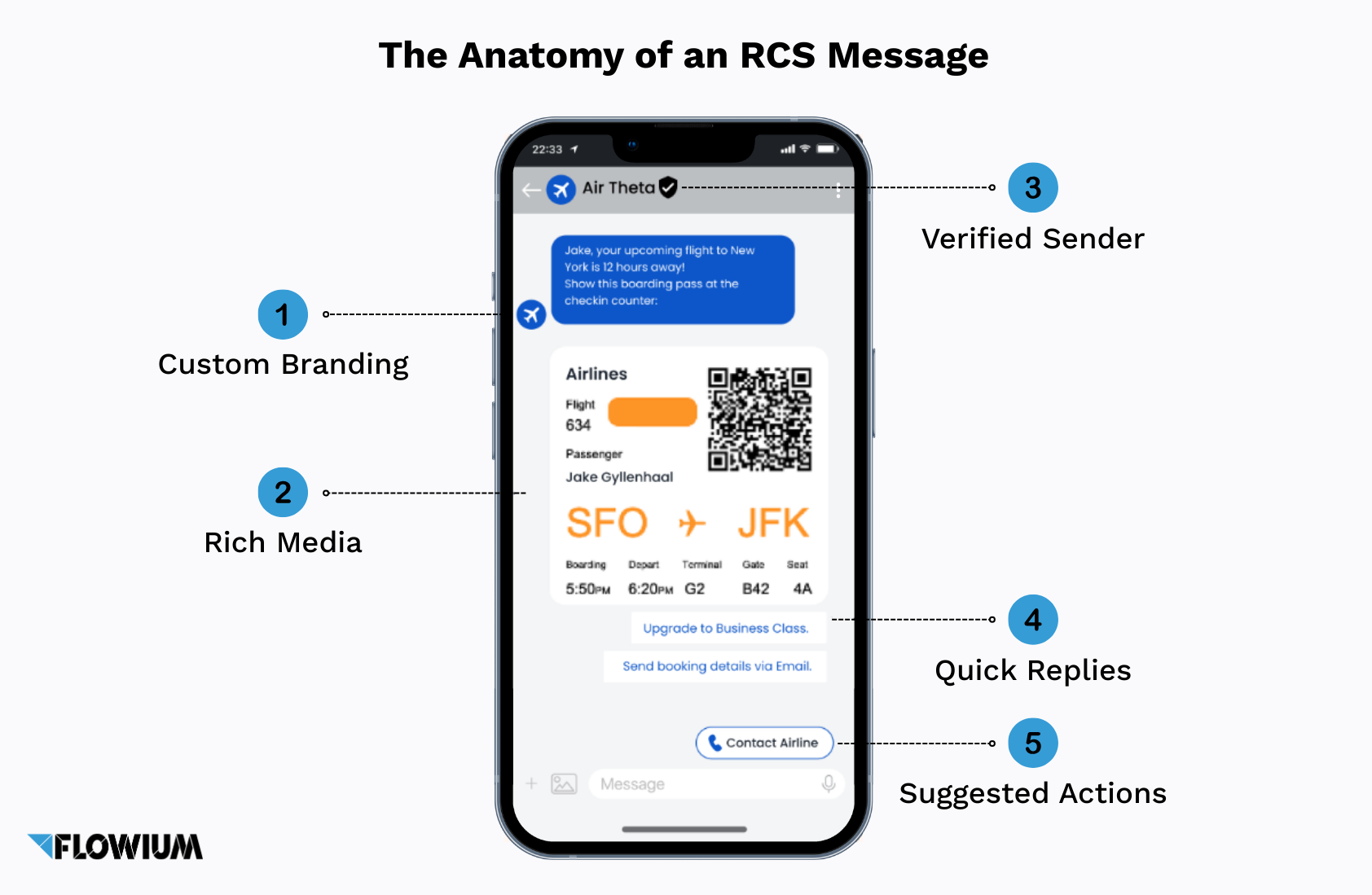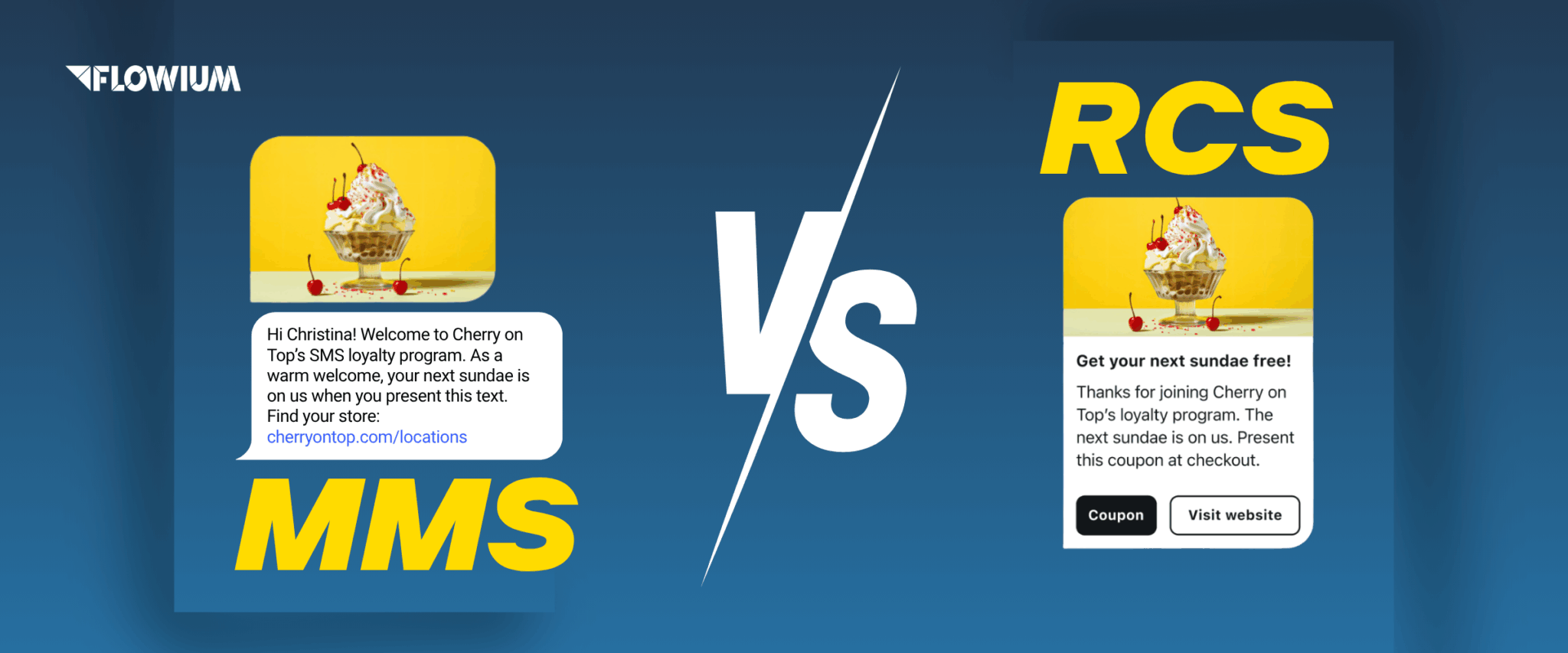Having an advanced text messaging strategy is essential for businesses facing increasing competition and more complex promotions. To ensure the effectiveness of your chosen strategies and maximize outreach, marketers employ modern messaging technologies such as RCS. However, when this technology is introduced to people for the first time, they often confuse it with MMS, which is more familiar to users. To draw the line between these two messaging channels, let’s compare them. Here, we’ll highlight the distinguishing features of RCS vs. MMS, examine the most common use cases to help businesses understand these messaging forms, and outline the benefits for marketing teams.
RCS vs MMS Definition
MMS and RCS are two major formats that you’ve seen if you’re looking to improve your communication approach. Both include multimedia message features, but your strategy will determine which is the best channel in terms of customer experience, branding, and engagement. Let’s start outlining the distinguishing characteristics of these formats by giving their definitions.
“RCS is more like the modern evolution of MMS. While MMS is limited and an extension of SMS, RCS is offers more of an interactive experience. Essentially, MMS is universal but basic, whereas RCS allows brands to send interactive messages, images, and replies, creating two-way conversations between the brand and customer (like chatting with a brand).”
Rumbi Nyagani
Strategist at Flowium
What is RCS?
RCS (Rich Communication Services) is a modern messaging standard that enhances a more traditional MMS by offering a richer, more interactive and visually engaging experience.
It offers you more opportunities to translate your brand’s voice and offer customers convenient ways of communication. Created by Google, RCS enables verified businesses to send rich, interactive texts over carrier networks and Wi-Fi.

Unlike third-party technologies like WhatsApp, RCS doesn’t require app downloads or sign-ups. It’s built directly into the default messaging app of devices (most Androids and limited iOS).
With the use of RCS, companies can benefit from:
- Vibrant visuals (High-quality pictures, GIFs, and documents)
- Instant actions (CTA like “Order Now,” “Check Out”) to increase engagement)
- Immersive experiences (Swipeable content carousels and branded message layouts)
- Authentic connections (Verified sender profiles to prove brand identity)
RCS is the first communications channel to incorporate rich features, branding capabilities, and worldwide reach into the main messaging app.
What is MMS?
MMS (Multimedia Messaging Service) is an enhanced version of traditional SMS that allows businesses to send rich, multimedia content, including images, audio, short videos (up to 40 seconds), and longer text messages. Unlike internet-based channels, MMS messages can reach customers without requiring mobile data or a Wi-Fi connection, ensuring accessibility across virtually all mobile devices.

Because of its high open rates and broad compatibility, MMS remains a powerful tool for marketers who want to blend reach with visual storytelling.
It’s particularly effective for campaigns that aim to:
- Capture attention with striking visuals
- Deliver concise yet engaging promotions
- Reach audiences seamlessly, regardless of device or connectivity
MMS is a messaging format that helps brands add a visual edge to their text promotions, enhancing recall and engagement while maintaining universal accessibility.
Key Difference Between RCS and MMS
The primary difference between the two messaging protocols can be seen in their feature sets. Let’s examine the main points of similarity and difference between RCS and MMS.

Business Verification
Having a verified business account is a great advantage, no matter the marketing channel, as it means that a sender’s profile was vetted beforehand. This reduces the chances of spoofing and helps to increase trust in your brand.
RCS
This protocol enables companies to create verified business profiles that include their logo, brand colors, and other visual elements. This verification helps customers quickly recognize legitimate communications and builds trust, which is especially critical for industries such as financial services and healthcare.
MMS
On the other hand, this format lacks any native sender verification or branding capability. Messages appear to come from generic numbers, which increases the risk of spoofing and reduces customer confidence.
Verification: This advantage obviously goes to RCS, as this format enables businesses to get verified sender profiles to increase trust.
Interactivity
Adding interactive elements to your message is a wonderful tactic to increase response rates and engagement. One of the most transformative aspects of RCS compared to MMS is its ability to include interactive components directly within the message.
RCS
Businesses can integrate:
- Clickable buttons
- Carousels for product browsing
- Suggested replies
- Even map and calendar integrations for directions or appointments.
This functionality allows brands to create app-like experiences without requiring users to download anything.
MMS
By contrast, MMS is limited to sending static images, videos, and links. It provides no built-in interactivity— users can only tap on links to continue the conversation externally.
MMS vs RCS Interactivity: Rich Communication Services offer far more interactive features that make it more efficient for engagement.
Insights and Advanced Analytics
Keeping track of the results of your campaigns through advanced analytics tools is crucial for measuring success and further growth of your marketing efforts. With the received insights, you can see weak points in your strategy and optimize it accordingly. Both compared messaging formats provide insight capabilities, but to a completely different degree.
RCS
This messaging format supports:
- Read receipts
- Delivery confirmations
- Typing indicators
- Engagement tracking for specific message components.
Such detailed feedback allows brands to measure how recipients interact with their messages and continuously refine their strategies based on real-world engagement data.
MMS
MMS provides minimal insight beyond basic delivery status, offering no real-time feedback or behavioral analytics.
Comparison Conclusion: RCS delivers far deeper analytical capabilities than MMS.
Support for Devices and Carriers
While MMS, along with SMS, keeps its prevalence in device support, the newer format makes some advancements too. Carriers and industry giants like Apple and Google have made large investments in RCS, which is regarded as the future of mobile texting. It is anticipated that RCS will establish itself as the new norm for cross-platform communication and significantly enhance the texting experience between iPhone and Android users.
RSC
This format was originally supported only on Android devices, but with iOS 18, Apple has begun enabling RCS compatibility in regions where carriers have activated routing. However, adoption still varies between operators and countries. For this reason, brands should always build SMS or MMS fallback paths to ensure reliable message delivery.
MMS
The fact that brands often use this messaging type as a fallback for RCS obviously points to its larger outreach. It has universal support across all devices and carriers, making it more predictable in terms of reach, although far less capable in terms of functionality.
RCS vs MMS Support: When it comes to support, MMS prevails, offering a more universal support.
Failover and Message Continuity
To have a fallback option or not to have… The answer will actually depend on the texting format you choose for your campaigns.
RCS
When an RCS message cannot be delivered because the device or data connection is unavailable, the system automatically falls back to SMS or MMS. This transition must be managed by a messaging platform to maintain conversation continuity.
MMS
MMS operates without such dynamic switching—messages are simply delivered as-is, regardless of network status.
Feature Comparison: Clearly, the fact that MMS doesn’t require setting up a fallback makes it more secure in terms of message continuity compared to RCS.
Opt-ins and Compliance
To maintain your sender reputation and avoid your campaigns being flagged as spam, you need to ensure your messaging complies with legal guidelines.
RCS
From a compliance standpoint, RCS follows the same consent rules as SMS: users must be able to easily opt in and opt out, and brands must clearly display these options. Additionally, RCS requires verification before a company can display its name or logo within a message thread, providing an extra layer of authenticity and protection against spoofing.
MMS
MMS also mandates opt-out functionality (such as replying “STOP”), but it does not include sender verification or any screening mechanism before use.
Compliance Comparison: Both messaging types follow the same guidelines when it comes to opt-in/opt-out rules.
Branding and Security
Many businesses strive to not just deliver a message but also get their brand identity across and make a long-lasting impression. Various branding features can help with that, but not all technologies provide them.
RCS
You can set up the official brand name and logo, and in some cases, a unique checkmark. This protocol supports branded, verified links that appear safer to both users and carriers. Such branding allows you to translate your business identity better, improves brand visibility and recall, and increases trust.
MMS
Unfortunately for businesses, MMS does not have this advantage. While you can use multimedia to express your brand’s voice (including logo, brand colors, etc.), this format doesn’t provide sende-profile verification.
Branding Feature Comparison: If we look at the branding capabilities, RCS wins over MMS, offering the benefits of verification for branded design and security.
Cost Efficiency
RCS
Although RCS setup and integration may require initial investment, its higher engagement rates and conversion potential make it more cost-effective in the long term.
MMS
This type, while simple to deploy, often incurs higher costs for multimedia messages and tends to produce lower ROI due to limited interactivity.
RCS vs MMS Feature Comparison
To compare these two kinds of message formats, let’s dissect a few more features.
| Feature | RCS | MMS |
|---|---|---|
| Content | Text, images, videos, buttons, carousels, branding, location, suggested replies | Text and multimedia, like images, video, and audio (limited size) |
| File Size | Up to about 100MB | Usually around 300KB |
| Branding | Logos, custom colors, verified sender IDs | Not supported |
| Interactivity | High-level (interactive buttons, chatbots, rich cards, click-to-call, location) | Viewing media only |
| Reach | Limited (depends on the device support) | Universal but with limited media quality |
| QR Code Support | Yes | No |
| Encryption | Yes | No |
| Cost for businesses | Higher than SMS/MMS but offers increased engagement and ROI | Higher than SMS (usually charged per message) |
| Compatibility | RCS-enabled iPhone and Android phones | All mobile devices in supported markets |
| Connectivity | Requires WiFi or cellular data | Users can receive MMS without a data plan or WiFi, depending on their messaging plan |
| Receipts and Indicators | Delivery, read, typing indicators | Delivery only |
| Analytics | Real-time pens, taps, and conversions tracking | Basic delivery statistics |
MMS vs RCS Use Cases
To help you see the difference between RCS and MMS, let’s look at the common use cases for both technologies. While some of them might be common in purpose, the implementation clearly differs due to the distinguishing features.
MMS Use Cases
Let’s look at the types of marketing campaigns where MMS may be beneficial.
- Product launch. When promoting a new product to your SMS list, providing a photo of the item will help increase interaction and interest.
- Restocking alerts. A picture with a replenishment alert message may pique your subscribers’ curiosity, especially if they signed up to be notified when the item is back in stock.
- Seasonal and holiday sales. An MMS marketing effort could improve the success of your seasonal or holiday sales. That is because a visual can capture your audience’s attention.
- Coupons and discounts. Include a graphic with your text campaign that offers members coupons or unique discounts. You could even give subscribers a QR code voucher that they may redeem in stores.
RCS Use Cases
RCS allows businesses to automate customized conversations through chatbots, providing prompt answers and keeping interactions engaging with buttons and rich media.
- One-Time Passwords: RCS OTPs are sent from branded, certified accounts, reducing phishing risks and building customer trust-ideal for banking and ecommerce.
- Campaigns for Promotion: RCS turns traditional promotions into interactive experiences with buttons and carousels, boosting click-through rates and engagement.
- Participation in Loyalty Programs: RCS enhances loyalty program launches through interactive cards, special offers, and easy sign-up. QR codes and chat-based redemption simplify reward use.
- In-app Purchases: Integrated with Google Wallet, RCS enables secure in-chat purchases, streamlining checkout and improving conversion with branded buttons and text.
- Proactive Notifications: RCS supports personalized alerts like low stock, purchase updates, or renewals, allowing quick action via rich media and buttons.
- Catalogs and Customized Newsletters: RCS delivers interactive catalogs and newsletters with product descriptions, images, and purchase options, combining convenience, personalization, and higher engagement.
You can find more use cases and their examples from real brands in our previous article about RCS marketing.
When to Use RCS Over MMS
The answer to whether your business should use RCS or MMS depends on many factors. The best option will largely depend on your messaging goals, use case, and audience.
Choose RCS if:
- Visual appeal is a priority. It supports high-resolution photos and videos, ideal for marketing messages.
- Custom branding is a must. You can include logos, colors, and other brand elements to maintain consistency.
- Interactivity is vital. RCS supports interactive features like buttons, tickets, and forms within messages.
Choose MMS when:
- Wide reach is essential. MMS works across all mobile carriers, ensuring universal compatibility.
- You desire simplicity. It’s perfect for straightforward communication, such as two-way customer support, without needing advanced features.
RCS vs MMS: Which Is Better?
RCS is clearly outperforming MMS in key engagement metrics, with data showing a significant performance gap between the two. RCS campaigns achieve click-through and conversion rates up to three times higher than traditional MMS texting. In 2024, RCS usage increased by 111% during Black Friday and Cyber Monday, proving brands are investing in results-driven channels. With estimated click-through rates of 18–48% compared to MMS’s 6-16%, RCS delivers greater personalization and interactivity. Overall, even a simple RCS message from a verified brand tends to generate better outcomes than an MMS, especially when integrated into a broader omnichannel strategy.
At the same time, don’t dismiss MMS just yet; it remains a valuable tool for marketers who require a dependable, familiar medium to drive revenue with clients.
MMS vs RCS Comparison Conclusion
When it comes to RCS vs MMS, there is no one-size-fits-all answer; the channel you choose depends on what works best for your clients and marketing objectives. MMS offers tried-and-true interoperability with various devices as well as the option for visual storytelling, making it ideal for reaching a large audience with effective messages. Meanwhile, RCS adds interactivity and app-like features to help you increase client engagement.
Not sure where and how to start with implementing any of these technologies in your marketing strategy? Contact Flowium for more information and professional advice.
FAQ
- Will RCS replace MMS/SMS?
Yes, RCS will eventually replace SMS and MMS due to its greater benefits for marketing. We believe RCS will become the standard way to send and receive text messages. However, since this technology still has its flaws and needs further improvement in terms of connectivity and device support, we don’t recommend rejecting SMS/MMS marketing just now. Additionally, even those businesses that have adopted RCS still need both SMS and MMS as fallback options for this newer technology.
- Is MMS still relevant in 2025?
Absolutely. MMS uses the cellular network to reach almost any handset, including feature phones and smartphones in low-bandwidth locations, and does not require users to enable data or Wi-Fi. This makes it indispensable for time-sensitive warnings, existing consumer bases, and broad-reaching marketing.
- RCS vs SMS vs MMS: what’s the difference?
While SMS only uses plain text over cellular networks and MMS adds multimedia (such as photographs or movies) but lacks RCS’s interactive and branded features, RCS is an enhanced messaging system that provides read receipts, verified branding, and rich media across data networks.





